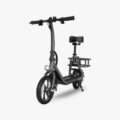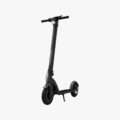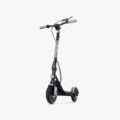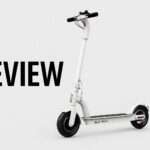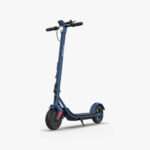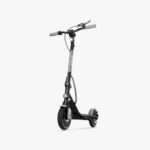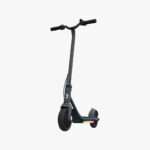- Home
- Scooters
- Electric Scooters
- Jetson Ryder
Jetson Ryder


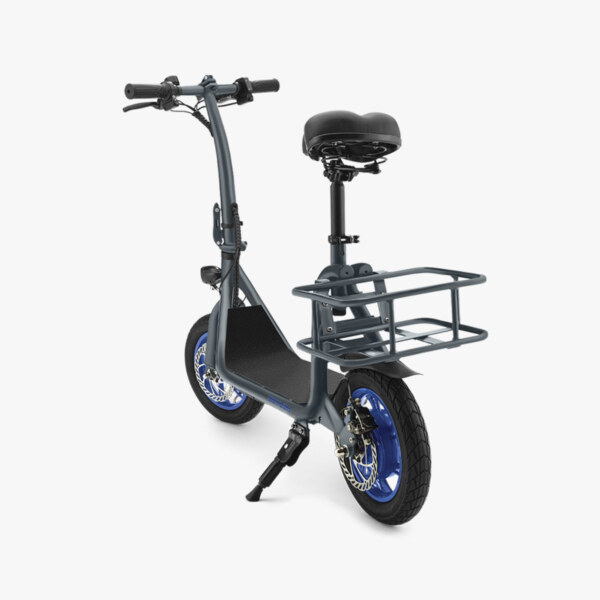
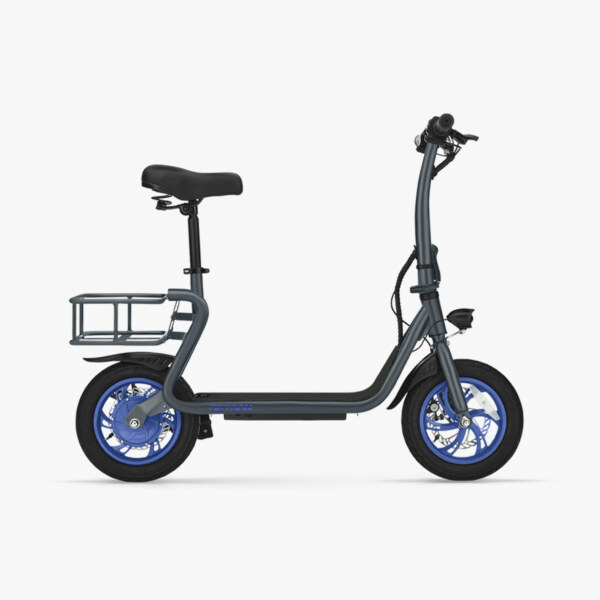
- Battery Range: 12 miles (19.3 km)
- Top Speed: 15.5 mph (25.0 km/h)
- Motor Power: 250 W
- Weight Capacity: 265 lb (120.2 kg)
- Charging Time: Approx. 5 hours
- Scooter Weight: 48.0 lb (21.8 kg)
PROS
- Seated design with rear cargo basket for practical errands
- 15.5 mph (25.0 km/h) top speed for neighborhood and campus use
- 12 in pneumatic tires improve comfort and stability
- 265 lb (120.2 kg) load rating suits a wide range of riders
- Integrated headlight for better visibility
CONS
- 12 mile (19.3 km) range is limited for longer commutes
- Single mechanical handbrake only
- No official IP rating and marked not water resistant
- 48 lb (21.8 kg) weight is harder to carry upstairs
Key Takeaways
- The Jetson Ryder is a seated electric scooter designed for comfort and short trips, featuring a 250W motor and a top speed of 15.5 mph.
- With a padded, height-adjustable seat and a rear basket, it prioritizes usability for casual riders and daily errands.
- The scooter’s lightweight design and compact frame make it manageable for storage and transport while offering stability with 12-inch pneumatic tires.
- Battery efficiency allows for typical ranges of 5 to 12 miles, making it suitable mainly for short urban rides or commutes.
- The Jetson Ryder is ideal for riders who prefer seated comfort and simple controls, but it’s not suitable for long distances or steep hills.
Table of contents
- What Is the Jetson Ryder?
- How the Jetson Ryder Works
- Key Specifications
- Design & Build Quality
- Performance Fundamentals
- Battery, Range & Efficiency
- Ride Quality & Comfort
- Braking & Safety Features
- Portability & Daily Usability
- Maintenance & Care
- Weather & Seasonal Considerations
- Jetson Ryder vs Alternatives
- Who the Jetson Ryder Is (and Isn’t) For
The Jetson Ryder is a seated electric scooter built for easy rides and simple daily trips. It feels like a small ride-on, not a toy, and it stays compact enough for tight spaces. So it works well for riders who want comfort, stability, and a calm pace more than sharp speed or long range.
What Is the Jetson Ryder?
The Jetson Ryder is a low step, seated electric scooter with 12 inch air filled tires and a built in rear basket. You sit on a padded, height adjustable seat, rest your feet on a central platform, and steer with a straight, simple handlebar. The whole setup feels familiar even if you have not used an electric scooter before.
Core parts.
- 250 watt rear hub motor
- 36V 6.0Ah lithium-ion battery
- Top speed up to 15.5 mph (about 25 km/h)
- Claimed range up to 12 miles (about 19 km)
- Max rider weight 265 lb (about 120 kg)
- 12 inch pneumatic tires
- Around 48 lb (about 21.8 kg) total weight
These numbers place the Jetson Ryder in the short trip, comfort focused class. So it fits neighborhood rides, campus moves, RV parks, and quick errands where a seat and basket matter more than raw power.
How the Jetson Ryder Works
The way the Jetson Ryder runs is straightforward and friendly.
The rear wheel holds a 250 watt hub motor. When you twist the throttle on the right grip, the controller sends power from the battery to that motor. Then the scooter rolls ahead with a smooth pull. Power delivery feels gentle, so new riders stay in control even at low speeds.
A compact controller sits inside the frame. It manages how strongly the scooter responds to the throttle. So starts feel gradual, and speed builds in a steady way instead of snapping forward.
The 36V 6.0Ah lithium-ion battery mounts in the body. You plug the charger into a regular wall outlet, then into the charge port until the light signals full. A full charge from low takes up to about five hours. With about 216 Wh on tap, riding style, tire pressure, rider weight, and terrain all shape how far you get.
Braking uses a hand operated rear mechanical setup. You pull the lever, and the rear wheel slows down. Light squeezes trim speed. Firmer pulls bring solid stopping for the speeds this scooter reaches.
The handlebar layout stays clean. You see the throttle, brake lever, simple controls, and headlight. That is all. No complex screens, no confusing modes. It feels close to a small powered bicycle control wise, just simpler.
Key Specifications
This table groups the Jetson Ryder specifications in a clear format for quick checks.
| Block | Item | Value |
|---|---|---|
| General | Model | Jetson Ryder (JRYDER-GRY) |
| Type | Seated electric scooter with rear basket | |
| Recommended age | 12+ years | |
| Max rider weight | 265 lb . approx 120 kg | |
| Vehicle weight | 48 lb . approx 21.8 kg | |
| Performance & Power | Motor | 250 W rear hub |
| Top speed | Up to 15.5 mph . approx 25 km/h | |
| Intended use | Short rides, casual use, light commuting | |
| Battery, Charging & Electrical | Battery | 36V 6.0Ah lithium-ion . approx 216 Wh |
| Claimed range | Up to 12 mi . approx 19 km | |
| Charging time | Up to 5 hours from low | |
| Charger | Works with standard household outlets | |
| Build & Dimensions | Frame | Step-through with integrated seat post |
| Tires | 12 in pneumatic, front and rear | |
| Unfolded size (L x W x H) | 45.7 x 19.1 x 35.85 in . approx 116.1 x 48.5 x 91.1 cm | |
| Folded dimensions | Handlebar folds down. length stays close to full. lower height for storage | |
| Seat | Padded, height adjustable | |
| Cargo | Fixed rear basket | |
| Safety & Control | Brake | Hand operated rear mechanical brake |
| Lights | Front LED headlight | |
| Support | Kickstand included | |
| Features & Extras | Riding position | Seated, upright |
| Throttle | Right side twist throttle | |
| Folding | Collapsible handlebar for easier storage and transport | |
| Cruise Control | Not listed for this model | |
| Warranty & Compliance | Warranty | Limited manufacturer coverage per product terms |
| Compliance | Built for consumer e-mobility rules. follow local laws |
Design & Build Quality
The Jetson Ryder looks like it wants life in real streets and paths, not just a showroom photo.
The step-through frame keeps mounting easy. You do not kick your leg high or fight for balance while you swing over. Then, once seated, your weight sits low and centered between the wheels. This layout helps with stability at slow speeds, which is where many people spend most of their time.
The central foot platform is flat and roomy. You can place both feet side by side, which feels natural. Grip texture on the surface holds your shoes in place in dry conditions. Plus, the 12 inch tires raise the ride height just enough to clear small edges and cracks better than tiny scooter wheels.
The seat sits on an adjustable post. You tweak the height so your legs and arms feel relaxed, not cramped. Padding is simple but decent for short and medium runs. Right behind it, the rear basket bolts to the frame. It keeps bags low and close to the wheel, so the scooter does not feel top heavy.
Up front, the cockpit keeps clutter down. Cables route along the frame. The controls sit where you expect them. Finish quality feels fair for its class, with a focus on function and easy ownership. It comes across as a small seated runabout that you actually use, not something you are scared to scratch.
Performance Fundamentals
The Jetson Ryder is built for calm, honest performance, and it does that job well.
From a full stop, the rear motor picks up in a smooth way. There is no harsh kick. So parking lots, paths, and crowded areas feel easier to handle. Riders who do not want sudden jumps in power tend to like this.
On flat ground, many riders can touch the listed 15.5 mph. Lighter riders sit closer to that mark. Heavier riders ride a bit under. The speed feels enough for relaxed bike lanes, quiet streets, and path use where control and awareness sit above raw pace.
On hills, the story changes. On grades around 7 to 8 percent, the scooter still climbs but slows. Riders far from the weight limit see slow but steady progress. Riders close to the top rating feel stronger drop off and need better run up space. Long, steep hills are not its strong side. So it fits towns and routes with gentle climbs and flat stretches.
The seated stance and 12 inch tires help with straight line stability. The scooter tracks calmly at its top speed range. When bolts stay tight, the bar does not feel twitchy. It feels like a small, steady chair on wheels more than a nervous kick scooter.
Battery, Range & Efficiency
The Jetson Ryder’s battery and motor combo target short, regular trips, and that match feels clear on the road.
The 36V 6.0Ah pack carries enough energy for up to 12 miles under light, ideal conditions. Real riding looks a bit different, so it helps to think in ranges.
In many cases.
- Around 7 to 10 miles (11 to 16 km) for a midweight rider on mostly flat ground at mixed speeds.
- Around 5 to 8 miles (8 to 13 km) with hills, more stops, a heavier rider, or colder air.
- Less range if you hold full throttle often or load the basket with heavy items.
So the strongest use case looks like several short hops per day, or a short round trip commute, with a bit of charge left when you get home.
A few habits keep the pack happier.
Try to charge before the battery runs all the way down. Store the scooter with some charge in a cool, dry space. Keep the charge port covered. Do not leave it sitting locked in direct blazing heat or freezing cold for days. Small choices like this help the scooter keep its normal range for longer.
Ride Quality & Comfort
Comfort is where the Jetson Ryder starts to feel like the right call for many riders.
You sit. Your hands rest at a natural height. Your feet sit flat. So slow rides, stop and go paths, and longer errands feel less tiring than standing the whole time. This matters for older riders, casual riders, or anyone who just wants a relaxed way to move.
The 12 inch pneumatic tires soak up small cracks and seams. They take the sharp edge off many bumps that harsh small solid wheels send straight through your legs. The scooter does not come with built in suspension, though. Deep potholes, broken patches, and curb hits still feel rough. A little care with line choice pays off.
Stem and frame feel steady at the speeds this scooter runs. When bolts stay tight, flex stays low and steering feels predictable. The rear basket, when loaded with normal bags, does not swing or pull awkwardly. Weight sits close to the frame, so the scooter stays calm.
Altogether, the Jetson Ryder delivers a friendly, forgiving feel on clean or decent pavement. It is the kind of ride many owners hand to family members without a long talk.
Braking & Safety Features
Braking on the Jetson Ryder stays simple, which helps real safety.
One hand lever runs the rear mechanical brake. A light pull slows you gently. A stronger pull brings the scooter to a stop over a short, steady distance for its top speed. The curve from light to firm feels easy to read, so riders pick it up quickly.
Good habits make a clear difference.
Start braking early instead of waiting. Keep both hands on the handlebar when you slow hard. Test the lever feel from time to time. If it pulls too close to the grip, adjust cable tension before your next main ride.
The built in front LED headlight helps you see and be seen in low light. For serious night riding, stronger front and rear lights raise visibility a lot, so many owners upgrade there. Reflective bits on the frame, basket, helmet, or jacket add more help in traffic.
The Jetson Ryder is listed as not water resistant. So heavy rain, puddles, and soaked roads raise risk, both for grip and electronics. Riders should treat it as a dry weather scooter first, with only careful use in light, brief damp moments.
Local rules on helmets, ages, and lanes change from place to place. Riders should follow their region’s laws and the manual’s advice.
Portability & Daily Usability
The Jetson Ryder is not feather light, yet it stays manageable for daily life.
At about 48 lb, lifting with both hands into a trunk or over a single step feels doable for many riders. For longer moves, rolling it is the better choice. The frame size stays compact for a seated scooter, and the layout fits into many small storage spots.
The folding handlebar helps a lot. Fold it down toward the deck, and the scooter’s height drops, which makes trunk, RV bay, hallway, or balcony storage easier. The frame itself stays one piece, so length does not shrink. Still, the lower stack and narrow width make parking simple.
The rear basket is a quiet win for daily use.
You can drop in a backpack, small grocery haul, or work gear instead of hanging things from the bar. The load stays stable and low. This keeps steering light and avoids bags bumping your knees.
For security, many riders lock through the frame and rear wheel to a solid rack or post. Indoor or covered parking helps protect finishes, contacts, and the seat.
Maintenance & Care
The Jetson Ryder stays low drama if you keep a basic routine.
Every week or two.
- Check tire pressure. Correct PSI keeps handling clean and helps prevent pinch flats.
- Test the brake. The lever should bite early and stop the scooter with confidence.
- Look at key bolts on the stem, handlebar, seat post, basket, and axles.
Each month.
- Inspect tires for cuts, objects, or worn tread.
- Scan cables and wires for rub marks or pinches.
- Wipe dust and grime from the frame, wheels, and contact points.
Battery habits.
- Avoid running it to empty when you can.
- Store with a partial charge if you pause use for weeks.
- Charge in a cool, dry place, not on a soaking wet or very hot surface.
Most of this work needs only basic tools and a few minutes. That fits the kind of rider who wants to ride more than wrench, yet still keep things safe.
Weather & Seasonal Considerations
Weather has a real impact on how you use the Jetson Ryder.
The scooter is not rated as water resistant. So heavy rain, deep puddles, and slush are poor conditions for it. Water in the wrong place can cause faults. Wet ground also cuts grip for the small contact patch of each tire.
If you get caught in light rain or pass through damp patches.
- Slow your speed.
- Avoid standing water that hides bumps or holes.
- Skip painted lines and metal covers when braking.
- Dry the scooter after the ride and let it sit before charging.
Temperature plays a role as well. Cold days reduce battery output, so range drops. Very hot storage spaces stress the pack and parts. Keeping the scooter indoors at moderate temperature between rides helps keep performance steady across seasons.
For traction and control, clean tires and correct pressure help in all conditions. Snow, ice, and deep mud do not match this scooter’s design. Two wheels, a seat, and smooth tread make those surfaces risky.
Jetson Ryder vs Alternatives
The Jetson Ryder sits in its own lane between stand-up scooters, small e-bikes, and bulkier mobility style machines.
Next to stand-up commuter scooters at similar power, it trades a lighter fold and tiny footprint for a full seat, big tires, and a basket. So riders who carry their scooter upstairs each day might lean toward a slim stand-up model. Riders who stay on ground floors and care about comfort and storage space on the scooter itself lean toward the Jetson Ryder. If you like the idea of a compact upright ride instead, the Jetson Racer offers a standing format that suits shorter, sportier hops.
Next to higher power or long range scooters, the Jetson Ryder looks mild. It does not chase big dual motors or huge packs. It aims for calm rides at neighborhood speeds. So thrill seekers and long distance riders need something stronger. Riders who just want a solid, seated runabout for a few miles per day fit here instead. For a more classic upright commuter feel with a simple deck layout, the Jetson Eris lines up as another compact option in the same family.
Next to many three or four wheel mobility units, the Jetson Ryder is lighter, narrower, and more nimble. It feels more like a casual personal vehicle. Still, it is not a medical device and does not replace the stability of multi wheel platforms. It matches people who feel fine on two wheels but want more support and storage than a bare scooter deck.
So the Jetson Ryder finds its spot with riders who value comfort, ease, and simple hardware for real weekday and weekend use.
Who the Jetson Ryder Is (and Isn’t) For
The Jetson Ryder is a strong match for riders who.
- Take short trips in town, on campus, or in private communities.
- Prefer to sit and ride in a relaxed position.
- Want a built in basket for bags, groceries, or daily gear.
- Live or travel in places with mostly flat routes.
- Like clear, simple controls without apps or complex modes.
It fits both teens and adults within the weight rating. The low step, seat, and stable stance can help riders who feel unsure on narrow, stand-up decks.
The Jetson Ryder is not the best choice for riders who.
- Need long daily rides beyond roughly 10 to 12 miles on one charge.
- Deal with long, steep hills all the time.
- Carry a scooter up many stairs each day.
- Want fast launches, trail riding, or off road fun.
- Plan to ride often in heavy rain or harsh winter mess.
For the people it targets, the Jetson Ryder feels friendly, practical, and easy to live with. It covers real world short trips without drama and keeps the experience simple.
Specifications
General
| Model The Model specifies the exact version or name of the scooter. It helps identify its unique design, features, and specifications within the manufacturer’s product line. Knowing the model makes it easier to compare options, find compatible accessories, or look up support information. | Ryder Electric Scooter |
| Brand The Brand identifies the manufacturer or company that designs and produces the scooter. A trusted brand is a sign of quality, reliability, and good customer support. Well-known brands often have higher standards for safety, performance, and after-sales service, giving you more confidence in your purchase. | Jetson |
| Release Date The Release Date indicates when the scooter model was officially launched on the market. This helps you know how current the design, technology, and features are. A newer release date often means updated components, improved performance, and the latest safety or smart features. | 18 November 2025 |
| Recommended Age Recommended Age indicates the minimum age range that the scooter is designed for, based on safety, size, and ease of use. Following the recommended age helps ensure that riders can handle the scooter’s speed, weight, and controls comfortably and safely. Always check local laws and use protective gear, especially for younger riders. | 12+ |
Performance & Power
| Motor Power (Wattage) What it means: The motor power, measured in watts (W), shows how strong the scooter’s electric motor is. Why it matters: Higher wattage usually means better acceleration, more torque, and improved performance on hills or rough terrain. For example, a 250W motor is good for flat city roads and light riders, while a 500W or 1000W motor provides more power for faster speeds or climbing steep inclines. | 250 W hub motor |
| Top Speed The Top Speed indicates the maximum speed that the scooter can reach under optimal conditions. It’s usually measured on level ground with a fully charged battery and an average rider weight. A higher top speed allows you to travel longer distances faster, but always ensure you ride within legal speed limits and your personal comfort zone for safety. | 15.5 mph (25.0 km/h) |
| Battery Capacity Battery Capacity refers to the total amount of energy the scooter’s battery can store, usually measured in ampere-hours (Ah) or watt-hours (Wh). A higher battery capacity means you can ride longer distances on a single charge, reducing the need for frequent recharging. Keep in mind that actual range can vary depending on rider weight, terrain, speed, and weather conditions. | 36 V 6.0 Ah (216 Wh) |
| Estimated Range per Charge The Estimated Range per Charge indicates the average distance the scooter can travel on a single full battery charge. This range is calculated under optimal conditions, such as flat terrain, moderate speed, and average rider weight. Real-world range may vary depending on riding style, terrain, weather, and load. A longer range means fewer recharges and greater freedom for longer trips. | 12 miles (19.3 km) |
| Hill Climb Ability Hill Climb Ability describes the maximum incline or slope that the scooter can handle while maintaining stable performance. It’s typically expressed as a percentage or in degrees. A higher hill climb rating means the scooter can tackle steeper hills without losing too much speed or power. Actual climbing performance may vary based on rider weight, battery charge, and terrain conditions. | Not specified |
| Drive System The Drive System refers to how power from the motor is delivered to the wheels. Electric scooters typically use either a hub motor (directly integrated into the wheel) or a chain/belt drive system. A high-quality drive system ensures smooth acceleration, efficient power transfer, and low maintenance. The choice of drive system affects performance, noise level, and overall ride experience. | Not specified |
Charging & Electrical
| Charging Time Charging Time indicates how long it takes to fully recharge the scooter’s battery from empty to 100% using the standard charger provided. Faster charging means less downtime and more time on the road. Actual charging time may vary slightly depending on battery capacity, charger output, and environmental conditions. | Approx. 5 hours |
| Battery Type Battery Type refers to the specific technology used in the scooter’s battery, which affects performance, lifespan, weight, and charging time. Most modern electric scooters use high-quality lithium-ion (Li-ion) batteries because they offer a good balance of energy density, durability, and low maintenance. A reliable battery type ensures consistent power delivery and longer riding ranges. | 36 V 6.0 Ah lithium-ion battery |
| Removable Battery A Removable Battery means the battery pack can be easily detached from the scooter for convenient charging and replacement. This feature allows you to charge the battery separately, swap it with a spare for extended range, or securely store it indoors in extreme weather. Removable batteries add flexibility and make it easier to keep your scooter powered up wherever you are. | No (internal pack) |
| Regenerative Braking Regenerative Braking is an energy-saving feature that converts some of the energy normally lost during braking back into battery power. When you slow down or brake, the motor works in reverse to generate electricity, which helps extend the scooter’s range and improves overall efficiency. This system also reduces wear on traditional brake components, leading to lower maintenance over time. | Not specified |
| Lighting Lighting refers to the built-in front and rear lights that enhance visibility and safety when riding in low-light conditions or at night. Good lighting helps you see the road ahead and ensures that other road users can see you. Many scooters include LED headlights, taillights, and sometimes brake lights or side reflectors for added safety and compliance with local traffic regulations. | Front LED headlight |
Build & Dimensions
| Scooter Weight Scooter Weight refers to the total weight of the scooter when fully assembled, including the battery. This affects how easy it is to carry, lift, and store the scooter when not in use. A lighter scooter is more portable and convenient for commuting, especially if you need to carry it upstairs or onto public transport. Keep in mind that a sturdy frame and quality components may add to the weight but also contribute to better durability and ride stability. | 48.0 lb (21.8 kg) |
| Maximum Rider Weight Maximum Rider Weight indicates the highest rider weight that the scooter is designed to safely support while maintaining optimal performance and stability. Staying within this limit helps ensure reliable acceleration, braking, and climbing ability, and it protects the frame, suspension, and motor from excessive strain. Exceeding the recommended limit may reduce performance and increase wear on components. | 265 lb (120.2 kg) |
| Deck Size Deck Size refers to the dimensions of the scooter’s standing platform. A wider and longer deck provides more foot space, allowing you to stand comfortably and adjust your stance while riding. A well-sized deck improves balance and stability, especially on longer rides or at higher speeds. Compact decks, on the other hand, help keep the scooter lightweight and portable. | Step-through frame with seat and rear cargo basket |
| Handlebar Height Handlebar Height refers to the distance from the deck to the handlebars, which affects your riding posture and comfort. An appropriate handlebar height helps you maintain good balance, reduces strain on your back and arms, and makes steering more comfortable. Some scooters have adjustable handlebars to fit riders of different heights, while others have a fixed height for a streamlined design. | Fixed |
| Folding Mechanism The Folding Mechanism describes how easily and securely the scooter can be folded for carrying and storage. A well-designed folding system lets you quickly collapse the scooter into a compact size, making it convenient to transport on public transit, store under a desk, or fit into a car trunk. Look for sturdy latches and safety locks to ensure the scooter stays firmly in place when folded or unfolded. | Handlebar folds down for storage |
| Dimensions Folded Dimensions indicate the size of the scooter when it’s fully folded. This measurement shows how much space the scooter will take up when stored or carried, making it easier to check if it will fit in your car trunk, under a desk, or in a closet. Compact folded dimensions are ideal for commuters who need to bring their scooter on public transport or store it in tight spaces. | Unfolded: 45.7 x 19.1 x 35.85 in (116.1 x 48.5 x 91.1 cm); Folded: Not specified |
| Material Material refers to the primary construction materials used for the scooter’s frame and key components. High-quality materials like aircraft-grade aluminum, reinforced steel, or durable composites provide strength, stability, and a lighter overall weight. A sturdy material ensures the scooter can handle daily wear and tear while maintaining safety and performance. | Aluminum alloy |
Safety & Control
| Brake Type(s) Brake Type(s) describe the braking systems the scooter uses to help you slow down or stop safely. Common brake types include mechanical brakes (like drum or disc brakes), electronic brakes, and foot brakes. Many scooters combine multiple braking systems for added safety and shorter stopping distances. The type and quality of brakes affect your control, especially when riding at higher speeds or on slopes. | Hand-operated brake (mechanical) |
| Suspension Suspension refers to the system that absorbs shocks and vibrations while riding, providing a smoother and more comfortable ride over uneven or rough surfaces. Scooters may have front suspension, rear suspension, or dual suspension for better shock absorption and stability. Good suspension helps reduce rider fatigue and improves control, especially when riding on bumpy roads or off-road paths. | None |
| Tire Type Tire Type refers to the kind of tires the scooter uses, which directly affects ride comfort, traction, and maintenance. Common types include solid (airless) tires, pneumatic (air-filled) tires, or hybrid options. Pneumatic tires offer better shock absorption and a smoother ride on rough surfaces, while solid tires are puncture-proof and require less upkeep. The right tire type helps ensure safe handling and a comfortable ride in different conditions. | 12 in pneumatic tires |
| Tire Size Tire Size indicates the diameter and width of the scooter’s tires, which affect ride comfort, stability, and how well the scooter handles different terrains. Larger tires generally offer better shock absorption and a smoother ride over bumps and rough surfaces, while smaller tires keep the scooter lighter and more portable. Choosing the right tire size helps ensure a balance between agility and comfort. | 12-inch |
| Kickstand The Kickstand is a built-in stand that allows you to park your scooter upright when it’s not in use. A sturdy kickstand keeps the scooter stable and prevents it from tipping over, protecting it from scratches and damage. It also makes storing and accessing your scooter more convenient, whether you’re at home, work, or on the go. | Side kickstand |
| Water Resistance Rating Water Resistance Rating indicates how well the scooter is protected against water and moisture, usually shown as an IP (Ingress Protection) rating. This rating helps you understand whether the scooter can handle light rain, splashes, or wet roads without damage. While most scooters are not fully waterproof, a good water resistance rating adds peace of mind when riding in changing weather conditions. Always avoid deep puddles or submerging the scooter to protect its electrical components. | Not specified |
Features & Extras
| Display/Console The Display (or Console) shows important real-time information about your ride, helping you monitor your scooter’s status at a glance. Typical displays show speed, battery level, distance traveled, and riding mode. Some models also include additional features like Bluetooth connectivity, app integration, or backlighting for better visibility at night. A clear and easy-to-read display enhances safety and convenience on every trip. | Simple handlebar battery indicator |
| Ride Modes Ride Modes refer to the different speed and power settings you can choose to match your riding style or road conditions. Common modes include eco for maximum range and energy efficiency, standard for everyday balance, and sport or turbo for higher speed and stronger acceleration. Switching between ride modes allows you to customize performance, conserve battery, and ride safely in various environments. | Not specified |
| Smart App Connectivity Smart App Connectivity lets you pair your scooter with a dedicated mobile app via Bluetooth. Using the app, you can monitor real-time ride stats like speed, battery level, and range, adjust settings such as ride modes or cruise control, lock the scooter for added security, and sometimes receive firmware updates. This feature adds convenience and allows you to personalize your riding experience right from your smartphone. | No dedicated smartphone app |
| Anti-Theft System The Anti-Theft System helps protect your scooter from unauthorized use or theft. This feature can include built-in alarms, electronic motor locks, GPS tracking, or remote locking through a mobile app. A good anti-theft system provides peace of mind when parking your scooter in public spaces, adding an extra layer of security to safeguard your investment. | Standard power and brake controls |
| Cruise Control Cruise Control allows you to maintain a steady speed without continuously holding the throttle. This feature makes longer rides more comfortable by reducing hand fatigue and providing a smoother, more relaxed riding experience — especially on flat, open roads or bike lanes. For safety, cruise control can usually be easily activated or deactivated while riding. | Yes (cruise function noted in retailer information) |
| Accessories Included Accessories Included lists the additional items that come with the scooter to enhance your riding experience and convenience. Common accessories may include a charger, kickstand, bell, lights, phone holder, or carrying strap. These extras add value by making your scooter safer, easier to use, and ready to ride straight out of the box. | Scooter, charger, user manual |
Warranty & Compliance
| Warranty Period The Warranty Period indicates how long the manufacturer guarantees the scooter against defects in materials and workmanship under normal use. A good warranty provides peace of mind, showing the brand’s confidence in its product quality. Always check what parts are covered, such as the frame, battery, and motor, and follow the maintenance guidelines to keep your warranty valid. | Not specified (refer to Jetson general warranty policy) |
| Certifications Certifications confirm that the scooter meets specific safety, quality, and environmental standards set by recognized organizations or regulatory bodies. Common certifications may include CE, RoHS, UL, or other local compliance marks, depending on your region. These certifications ensure that the scooter is manufactured to high standards and is safe and legal to use in your country. | Conforms to local micromobility regulations where applicable |


